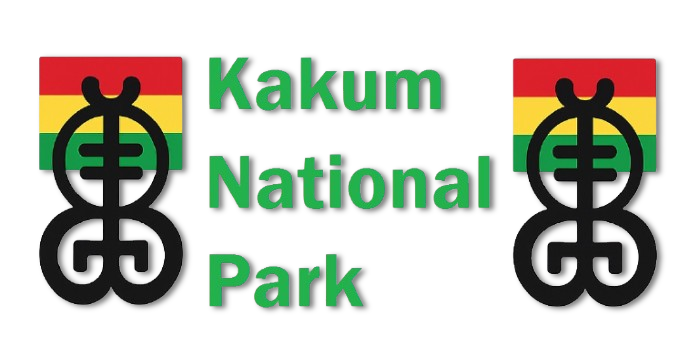
Explore Ghana's forts, National Parks, and Hidden History – your journey starts here!
Find your roots and rise — Ghana3d.com Gateway Experience 360. Your ultimate guide to cultural, historic, and soul-stirring adventures.!
Nestled in Ghana’s Central Region, Kakum National Park covers about 375 km² of tropical rainforest and is part of the Upper Guinean Forest biodiversity hotspot. national-parks.org+3ecoafrica-travel.com+3UNESCO World Heritage Centre+3
Inside its dense canopy and forest floor live a number of globally threatened and endangered species:
The forest elephant, African forest elephant (Loxodonta africana cyclotis) — Kakum once housed Ghana’s densest population of forest elephants. national-parks.org+2ecoafrica-travel.com+2
The giant bongo antelope (Giant bongo, Tragelaphus euryceros) — a forest‑dwelling antelope with striking markings, listed among the park’s most notable endangered fauna. ecoafrica-travel.com+1
The Roloway monkey (Roloway monkey, Cercopithecus diana roloway), classified as Critically Endangered, is found in the park. ecoafrica-travel.com+1
The yellow‑backed duiker (Yellow‑backed duiker, Cephalophus silvicultor), vulnerable, and other antelope species that rely on intact forest habitat. ecoafrica-travel.com+1
Pangolins and dwarf/west African crocodiles. For example, reports for the area point to vulnerable tree pangolin (Tree pangolin, Phataginus tricuspis) and dwarf crocodile species facing serious threat from habitat loss and poaching. threscoal.org
These species highlight Kakum’s global conservation importance — not just for Ghana, but for West Africa’s remaining rainforest ecosystems. - Read More Below
The park protects one of the last sizeable tracts of Upper Guinean rainforest — a forest type that has been severely reduced across West Africa. IGES+1
It offers habitat continuity for forest‑dependent species, many of which cannot survive in fragmented or degraded forest.
It supports ecological functions: elephants for seed dispersal, large antelopes for vegetation dynamics, pangolins for insect control, and so on.
It provides eco‑tourism potential (e.g., the famous canopy walkway) which can channel revenue to conservation and local benefit. ecoafrica-travel.com+1
Because of this, any threats to Kakum’s species or habitat have outsized implications for biodiversity.
While Kakum’s conservation value is high, the park is not isolated from human pressures. Surrounding communities and their livelihoods are deeply intertwined with the forest ecosystem — and this creates tensions.
Many farms lie within close proximity to Kakum. One report notes that around 60 farming communities, totalling about 1,200 households, live within a 5 km radius of the park. These communities face repeated crop‑raiding by elephants and other wildlife, leading to food insecurity and loss of income. FAOHome+1
For example, in the Assin South District, elephants from Kakum have been reported to destroy farmlands — maize, yam, cassava, cocoa — causing significant losses and distress to farmers. Adomonline.com
The creation and legal enforcement of the park have also restricted community access to forest‑based resources. A study reports that local people can no longer freely gather medicinal plants, perform forest rituals, or use certain forest areas because it is now legally an offence to be seen with forest products. 9pdf.net
These restrictions disrupt traditional practices and cultural heritage, which in turn can erode local support for conservation.
Other threats include habitat degradation from illegal logging, agricultural encroachment, and even mining interest in the park zone. For instance, one report indicates mining companies targeting Kakum for gold exploration. ghenvironment.com
When large‑scale economic interests threaten, local communities may feel sidelined or insufficiently compensated — contributing to resentment, conflict, and potential for illegal activity.
Addressing these competing interests requires integrated, inclusive approaches. Some key strategies:
Human‑Elephant Conflict Mitigation: Projects are underway at Kakum to reduce conflicts — e.g., training 5,000 people in 10 fringe communities about elephant value, and encouraging adoption of chilli‑fence crop protection methods among farmers. eocaconservation.org
Community Engagement & Benefit Sharing: Ensuring that local communities receive real benefits from tourism, employment opportunities, and forest use concessions helps build buy‑in for conservation.
Sustainable Livelihoods: Alternatives to forest exploitation (e.g., eco‑tourism, agroforestry) can reduce pressure on wildlife habitat while maintaining local income.
Cultural Heritage Respect: Safe corridors for traditional forest use, recognition of sacred sites, and participatory management enhance the culture‑nature link.
Law Enforcement + Local Participation: Protecting endangered species needs enforcement (against poaching, illegal logging) and local involvement — when communities feel ownership, compliance improves.
For Kakum’s rare species to thrive, the park must remain intact, safe from poaching, and supported by vibrant, secure local communities. That means:
Maintaining contiguous forest to support forest elephants, bongos, pangolins and primates.
Preventing further habitat fragmentation from mining, farming or logging.
Strengthening community‑park collaboration so that conservation doesn’t feel like exclusion but inclusion.
Monitoring endangered populations, conducting research, and using eco‑tourism revenues strategically.
Kakum isn’t just another national park — it’s a stronghold for endangered forest species in West Africa, a region where many forests have been lost. How Kakum resolves the conservation‑community dilemma could become a model for other protected areas in Africa.
Protecting Kakum means protecting forest elephants, bongos, pangolins, monkeys and more. But it also means protecting local cultures, livelihoods and landscapes. The two aren’t enemies — they must be partners.